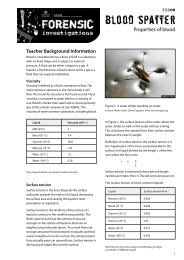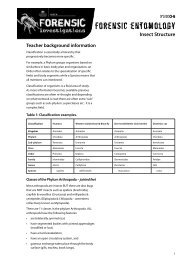FSE 11 Rearing flies [PDF File, 388.4 KB]
FSE 11 Rearing flies [PDF File, 388.4 KB]
FSE 11 Rearing flies [PDF File, 388.4 KB]
Create successful ePaper yourself
Turn your PDF publications into a flip-book with our unique Google optimized e-Paper software.
<strong>Rearing</strong> <strong>flies</strong>The best time to rear <strong>flies</strong> is when the temperature isbetween 20-30 o C. Really hot days are NOT suitable for<strong>flies</strong>.Equipment•Substrate – baked sardines (not pickled) OR liverpate*• Small foam meat tray.•Lunchbox – big enough for the meat tray to fit inwith 5cm space on each side.• Dry sand – enough for 4cm depth in the lunchbox.• Tulle or net material – acts as mesh.•Elastic band or the top cut out of the lunchbox– see below.*Chrysomya (hairy maggots) attracted to fish.*Calliphora (smooth maggots) attracted to liver.Method•Set the meat trays with the substrate in a lunchboxon a 4cm bed of dry sand. Do NOT cover the trays.• Use approximately 3 sardines per tray. From thissize there will be an egg mass of 100-200 maggots.• Place the lunchbox(s) outside.• During summer leave the lunchbox outsidebetween 24-48 hours. During cooler months leavefor 5 days. Leave outside until maggots are visible.• Bring the trays inside and cover with the netmaterial – secure with an elastic band or the cutoutlid.• The lunchboxes will get very smelly – as they donot require light they can be placed in places suchas:ö Roof tops (wind takes away a lot of smells)ö Garden shedsö Fumehoodsö Incubators• It is important that the food source remains moist– mist with a spray bottle of water daily.• Keep an eye on the food source – add extra foodas necessary.• Expect a mortality rate of approximately 10%.<strong>FSE</strong><strong>11</strong>fo r en sic ento m o lo gyTeacher Background Information
<strong>FSE</strong><strong>11</strong>fo r en sic ento m o lo gyTeacher Background InformationTable 1: As maggots develop through each larvalstage they become bigger. The table lists the averagesize of fly life stages.Life StageEggs 2-3Larvae – 1 st stage 2-4Larvae – 1 st stage 5-8Size mmLarvae – 1 st stage 10-15Pupae 6-10Table 2: Each larval stage can be identified throughthe number of slits in each pair of spiracles found inthe posterior segment of a maggot.Larval stageFirst instarSlits within the spiraclesin the posterior segment1 slit within each spiracle.RequireMicroscope– difficult to see.Second instar 2 slits within each spiracle MicroscopeA maggot has a pointy end (mouth parts) and a bluntend. The posterior segment of the blunt end containsspiracles that are used for breathing.Third instar3 slits within each spiracleHand lens (x20) isoften sufficientFigure 2: A diagram of a typical maggot. Thepointy end is the anterior and has the mouthparts.The posterior segment is the blunt end and has thespiracles used for breathing.Diagram courtesy of Dr Ian Dadour, Centre for Forensic Science, UWA.Figure 3: A diagram showing a cross-section of theposterior segment of a maggot. A pair of spiraclesis shown, each with 3 slits indicating a third stagemaggot.Diagram courtesy of Dr Ian Dadour, Centre for Forensic Science, UWA.
<strong>FSE</strong><strong>11</strong>fo r en sic ento m o lo gyTeacher Background InformationPrepare maggots for microscopyMaggots are killed in near-boiling water. An easyway to do this is to boil a kettle and then leave it fora couple of minutes. After 2 minutes, add the nearboilingwater to a petri-dsh containing the maggot(s).Leave the maggot in the hot water for 10 seconds.Using”soft” forceps, place the maggot in a 70%alcohol solution and leave for approximately 2minutes.MeasurementsDuring the lifecycle of the <strong>flies</strong>, students should takethe following measurements.. Daily maximum and minimum temperatures.2. Length (mm) of maggots.3.Note the date, time and number of changesfrom larvae development to adult emergence.The maggot is then ready for measurement andmicroscopy. (Leave the maggot in a petri dish whileunder the microscope.)PupationAfter approximately 3-5 days, the maggots willpupate. The maggots will migrate off the food sourceinto the sand.When all maggots have migrated you will be able toremove the meat tray with the food source from thelunchbox. This will be a biohazard so wear protectivegloves and dispose of appropriately.Keep the mesh on top of the lunchbox.The pupa will take between 12-14 days to emerge asadults.The <strong>flies</strong> will die in a couple of days after they haveemerged as they have no food source.After they have died, remove from the container andidentify the species of fly through the classificationkey (provided) and pictures. (<strong>FSE</strong>08)
Stage 1 Stage 2 Stage 3D1Brown blowfly,abdomen tippedwith purpleC1Brown blow<strong>flies</strong>D2Brown blowfly,abdomen brownAAll of thetrapped <strong>flies</strong>B1Green orbrown <strong>flies</strong>C2Green blow<strong>flies</strong>D3Small green blowfly,bush fly sizedD4Large green blow<strong>flies</strong>E1Green blow<strong>flies</strong>,grey abdomen,grey thoraxE2Entirely greenblow<strong>flies</strong>F1Green blowfly withwhite “ear” spiracleon side of headF2Green blow<strong>flies</strong>“ear” spiracles blackB2Black or grey<strong>flies</strong>C3Mainly grey <strong>flies</strong>C4Black <strong>flies</strong>,house fly-sized,brown eyesD5Small to large grey<strong>flies</strong>, 3 stripes onthorax, chequeredabdomenD6Grey <strong>flies</strong>, 4 stripeson ThoraxE34 stripes alongthorax in 2 pairs,e.g. II IIE44 stripes along thoraxin 2 Y-shapedpairs, e.g. Y YF3Bush<strong>flies</strong>, eyesapart, belly blackishto greyF4Bush<strong>flies</strong>, eyesclose together,belly yellowishClassification Key adapted from the Bioscan Entomology in Schools Project, 1995. Courtesy Dr Ian Dadour, The Centre for Forensic Science, UWA.<strong>FSE</strong><strong>11</strong>fo r en sic ento m o lo gyTeacher Background InformationCalliphora dubiaCalliphora varifonsandCalliphora albifrontalisChrysomya varipesCalliphora robustaChrysomya rufifaciesG1Greenish blow<strong>flies</strong>,plain green to bronzegreenabdomenLucilia cuprinaandLucilia sericataG2Green blow<strong>flies</strong>, bluishtinge to abdomen,large headChrysomyamegacephalaSarcophagidaeMusca domesticaMusca vetustissimaFemale bush flyMusca vetustissimaMale bush flyHydrotaea rostrata


![FSE 11 Rearing flies [PDF File, 388.4 KB]](https://img.yumpu.com/41885287/1/500x640/fse-11-rearing-flies-pdf-file-3884-kb.jpg)
![FSP 19 Anthropometry [PDF File, 298.3 KB]](https://img.yumpu.com/51210323/1/184x260/fsp-19-anthropometry-pdf-file-2983-kb.jpg?quality=85)


![FSE 09 Case studies [PDF File, 140.2 KB] - Centre for Learning ...](https://img.yumpu.com/48750159/1/184x260/fse-09-case-studies-pdf-file-1402-kb-centre-for-learning-.jpg?quality=85)
![FSE 03 [PDF File, 125.2 KB] - The University of Western Australia](https://img.yumpu.com/47991868/1/184x260/fse-03-pdf-file-1252-kb-the-university-of-western-australia.jpg?quality=85)
![FSE 01 Overview [PDF File, 163.0 KB]](https://img.yumpu.com/47583056/1/184x260/fse-01-overview-pdf-file-1630-kb.jpg?quality=85)
![FSE 10 Teachers activity [PDF File, 3.0 MB] - Centre for Learning ...](https://img.yumpu.com/45506425/1/184x260/fse-10-teachers-activity-pdf-file-30-mb-centre-for-learning-.jpg?quality=85)

![Chapter 03 [PDF File, 468.5 KB] - Centre for Learning Technology](https://img.yumpu.com/44881443/1/184x260/chapter-03-pdf-file-4685-kb-centre-for-learning-technology.jpg?quality=85)
![Chapter 09 5 [PDF File, 192.4 KB]](https://img.yumpu.com/44599682/1/184x260/chapter-09-5-pdf-file-1924-kb.jpg?quality=85)
![FSB 03 [PDF File, 151.9 KB]](https://img.yumpu.com/43260078/1/184x260/fsb-03-pdf-file-1519-kb.jpg?quality=85)

![FSP 26 Crime Dossier [PDF File, 3.2 MB]](https://img.yumpu.com/36466452/1/184x260/fsp-26-crime-dossier-pdf-file-32-mb.jpg?quality=85)
![FSE 07 Forensic entomology [PDF File, 196.9 KB]](https://img.yumpu.com/35416705/1/184x260/fse-07-forensic-entomology-pdf-file-1969-kb.jpg?quality=85)